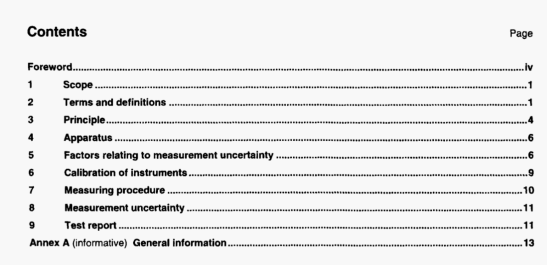ISO 3543 pdf download – Metallic and non-metallic coatings – Measurement of thickness -Beta back scatter method.
radioactive source sealed in a container or having a bonded cover, the container or cover being strong enough to prevent contact with and dispersion of the radioactive material under the conditions of use and wear for which it was designed
(ISO 921:1997, definition 1094]
NOTE Also referred to as sealed isotope.
2.15
aperture
opening of the mask abutting the test specimen and that determines the size of the area on which the coating thickness is to be measured
NOTE This mask is also often referred to as a platen, an aperture platen or a specimen support.
2.16
source geometry
spatial arrangement of the source, the aperture and the detector, with respect to each other
2.17
dead time
time period during which a Geiger-Muller detector is unresponsive to the receipt of further beta particles
2.18
resoMng time
recovery time of the Geiger-Muller detector tube and associated electronic equipment during which the counting circuit is unresponsive to further pulses
2.19
basis material basis metal
material upon which coatings are deposited or formed
(ISO 2080:1981 • definition 134]
substrate
material upon Which a coating is directly deposited
NOTE For a single or first coating the substrate is identical with the basis material: for a subsequent coaling the ntenneiate coating is the substrate
[ISO 2080:1981, definition 6301
3 Principle
When beta particles impinge upon a material, a certain portion of particles is backscattered. This backscatter is essentially a function of the atomic number of the material.
If the body has a surface coating, and if the atomic numbers of the substrate and of the coating material are sufficiently different, the intensity of the backscatter will be between two limits: the backscatter intensity of the substrate and that of the coating. Thus, with proper instrumentation and, if suitably displayed, the intensity of the backscatter can be used for the measurement of mass per unit area of the coating, which, provided that it is of uniform density, Is directly proportional to the thickness, I.e., to the mean thickness within the measuring area.
5.1 Counting statistics
Radioactive decay takes place in a random manner. This means that, during a fixed time interval, the number of beta particles backscattered will not always be the same. This gives rise to statistical errors inherent in radiation counting. In consequence, an estimate of the counting rate based on a short counting interval (for example. 5 s) can be appreciably different from an estimate based on a longer counting period, particularly if the counting rate is low. To reduce the statistical error to an acceptable level, the counting interval has to be long enough to accumulate a sufficient number of counts.
For counts normally made, the standard deviation. a will closely approximate the square root of the absolute count. that Is a Ji; in 95 % of all cases, the true count will be within X ± 2 a To judge the significance of the precisn,
it is often helpful to express the standard deviation as a percentage of the count, that is ioo./iix, or lOOJi Thus, a count of 100 000 will give a value 10 times more precise than that obtained with a count of 1 000. Whenever possible, a counting interval shall be chosen that will provide a total count of at least 10 000, which would correspond to a standard deviation of 1 % arising from the random nature of radioactive decay.
Direct-reading instruments are also subject to these statistical random errors. However, it these instruments do not permit the display of the actual count rate, one way to determine the measuring precision is to make a large number of repetitive measurements at the same location on the same coated specimen, and to calculate the standard deviation by conventional means.
NOTE The precision of a thic$ness measurement by beta backscatter is always less than the precision described in 5.1, as It also depends on the other factors described In 5.2 to 5.17.
5.2 Coating and substrate materials
As the backscatter intensity of a measurement depends on the atomic numbers of the substrate and of the coating, the uncertainty of the measurement will depend to a large extent on the difference between these atomic numbers; thus, with the same measuring parameters, the greater this difference, the more accurate the measurement wilt be.
ISO 3543 pdf download – Metallic and non-metallic coatings – Measurement of thickness -Beta back scatter method
